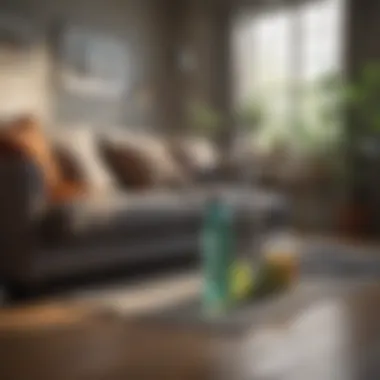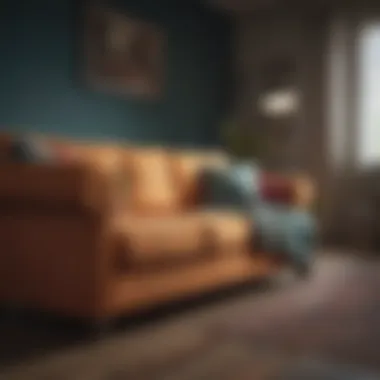Expert Guide to Cleaning a Used Fabric Couch


Intro
Cleaning a used fabric couch is an important task for maintaining its appearance and extending its lifespan. This process demands careful attention to detail, as improper cleaning can damage the fabric or reduce its integrity. Many individuals are unaware of how to approach this cleaning effectively, resulting in frustration and potential mishaps. This guide aims to break down the steps required to restore your couch while ensuring its quality is preserved.
The state of your fabric couch reflects not only your personal taste but also your dedication to maintaining a clean and inviting living space. It's crucial to equip yourself with the right knowledge and tools. With this information at your fingertips, you will be able to achieve a fresh and revitalized couch that enhances your home’s ambiance.
In the sections that follow, we will cover preparation techniques, appropriate cleaning methods, solutions to use, and post-cleaning care advice. Emphasis will be placed on safety and material types to promote optimal results.
Preparatory Measures
Before diving into the cleaning process, preparation is key. This ensures you have a clear plan and the right tools ready.
- Gather Supplies
- Assess the Fabric
- Test Cleaning Solutions
- Remove Loose Debris
- Vacuum cleaner with upholstery attachment
- Soft brush or lint roller
- Cleaning solutions suitable for your fabric type
- Microfiber cloths
- Sponge and water
- Identify the type of fabric you are dealing with.
Different materials, such as polyester, cotton, or microfiber, have unique cleaning requirements. Check any tags for specific cleaning instructions.
- Apply a small amount of your chosen cleaning solution to an inconspicuous area.
Ensure that it does not cause discoloration or damage.
- Use the vacuum cleaner to pick up dust, hair, and other loose particles.
Paying attention to seams and crevices can enhance the overall cleanliness.
"Preparation is the foundation of effective cleaning."
Selecting Appropriate Cleaning Methods
Once your couch is prepped, it's time to choose the cleaning method.
- Spot Cleaning for Stains
- Upholstery Shampoo
- Steam Cleaning
- Professional Cleaning
- Use a mix of mild detergent and water.
- Dampen a cloth with the solution and gently blot the stained area.
- For a deeper clean, consider using upholstery shampoo.
- Follow the product instructions carefully to ensure proper application.
- For fabric safe for steam cleaning, using a steam cleaner can be very effective.
- It removes dirt without harsh chemicals, leaving the surface refreshed.
- If the couch is significantly soiled or stained, professional cleaning services can provide profound results.
- It may be worth the investment to maintain the fabric’s integrity.
Post-Cleaning Care Suggestions
After cleaning, taking care of your fabric couch is essential to maintain its pristine condition.
- Regular Maintenance
- Address Spills Immediately
- Protective Treatments
- Conditioning the Fabric
- Vacuum at least once a month to prevent dirt accumulation.
- Flip and rotate cushions regularly for even wear.
- Blot spills with a clean cloth right away.
- Avoid rubbing, which can spread the stain.
- Consider applying a fabric protector spray.
- This can create a barrier against future stains.
- Use a fabric conditioner once a year.
- This helps maintain the soft feel of the material.
With these guidelines, your fabric couch can be revived and preserved. Regular attention and care will ensure that it remains an attractive centerpiece of your living area.
Understanding Fabric Couch Materials
Understanding the materials used in fabric couches is crucial for effective cleaning and maintenance. Different fabrics have unique properties, which impact how they should be cleaned. Recognizing the materials also helps in determining which cleaning solutions are safe to use, thus preserving the integrity of the couch. In this section, we will cover common types of fabric used, and how to identify your specific fabric type.
Common Types of Fabric Used
Microfiber


Microfiber is a synthetic fabric known for its soft texture and durability. It consists of ultra-fine fibers that make it resistant to stains and spills, thus making it a highly beneficial choice for homes with children or pets. This type of fabric repels liquids effectively, which simplifies the cleaning process. One important characteristic of microfiber is its ability to resist mildew and mold, due to its quick-drying properties. However, it can attract dust and pet hair, which means regular vacuuming is essential to maintain its appearance.
Canvas
Canvas is another popular choice for fabric couches. This fabric, made from cotton or linen, is known for its sturdy and breathable nature. Canvas can withstand wear and tear, making it a reliable option for high-traffic areas. A key characteristic of canvas is its ability to be easily cleaned with mild detergent and water. This makes it a practical option for those who prioritize easy maintenance. Nonetheless, canvas may fade over time when exposed to direct sunlight, which should be considered prior to purchase.
Velvet
Velvet offers a luxurious look and feel, making it an appealing option for many homeowners. It is typically made from polyester and has a rich texture that adds elegance to any room. The softness of velvet is undeniably its standout feature, providing comfort and style. However, it's important to note that it can be more challenging to maintain than other fabrics. If not cleaned regularly, velvet can trap dust and dirt, leading to a dull appearance. Additionally, using inappropriate cleaning solutions can cause the fabric to lose its luster.
Identifying Your Fabric Type
Identifying the specific fabric type is an essential step before cleaning. Doing so allows for selection of the appropriate products and techniques, therefore avoiding potential damage to the material. Here, we will examine two easy methods for identifying your fabric type: label inspection and texture examination.
Label Inspection
Label inspection is the most straightforward way to identify your fabric type. Most couches come with tags that indicate the fabric composition and recommended care instructions. Reviewing these labels provides valuable information about cleaning methods and solutions that are safe to use. It is an important step that should never be overlooked. Sometimes, labels are not available or may have worn off, which leads to the second method of identification.
Texture Examination
Texture examination involves physically feeling the fabric to determine its type. By running your hand across the material, you can identify specific characteristics. For example, if the fabric feels soft and inviting, it may be microfibre or velvet. In contrast, a rougher texture may indicate canvas. This method allows a more tactile understanding of the couch's fabric, albeit it may not be as precise as label inspection.
Identifying your fabric type ensures effective cleaning and helps maintain your couch’s quality.
Preparing for Cleaning
Preparing for cleaning a used fabric couch is a crucial step that can significantly affect the outcome of the entire cleaning process. It lays the groundwork for an effective restoration, ensuring that the right methods and supplies are utilized. The goal here is to provide a structured approach, minimizing the risk of damage while enhancing the overall cleanliness and appearance of the fabric. This preparation phase involves two key aspects: gathering necessary supplies and conducting a thorough pre-cleaning inspection.
Gathering Necessary Supplies
Cleaning Solutions
Cleaning solutions are the foundation of effective fabric couch cleaning. They play a critical role in removing dirt, stains, and odors, which may have accumulated over time. Popular options include enzyme-based cleaners, which specifically target organic stains like food and pet accidents. These solutions are beneficial because they break down stains on a molecular level, making them easier to remove without heavy scrubbing.
Some cleaning solutions are water-based, making them gentle on many fabric types while still being tough on grime. However, they sometimes require a longer drying time, so it is important to consider this aspect when choosing a solution. Always check for compatibility with your couch fabric to avoid discoloration or damage.
Tools and Equipment
The tools and equipment you choose can make a significant difference in the cleaning process. A high-quality vacuum cleaner with upholstery attachments is essential to remove loose debris and dirt effectively. Additionally, soft-bristle brushes are invaluable for gently agitating the fabric, helping to lift dirt without causing any harm.
Steam cleaners are another effective tool, especially for deep cleaning and sanitizing purposes. They can reach into fibers that may have absorbed stains or odors. However, be cautious with the heat settings, as some fabrics may be sensitive to high temperatures. Choosing the right tools and properly using them will enhance the effectiveness of your cleaning efforts.
Pre-Cleaning Inspection
Assessing Damage
Assessing damage before you clean is vital for a successful cleaning experience. It allows you to identify any existing issues, whether they are tears, fading, or worn areas. Knowing the extent of damage can guide your approach, ensuring you do not make the situation worse through aggressive cleaning methods. Often, a little care can restore the couch's appearance without further intervention. Common damage areas include seams, cushions, and areas with frequent contact like armrests.
Taking time to assess damage helps in planning the cleaning process, which may include gentle methods for fragile areas or targeted repairs prior to cleaning.
Testing Cleaning Solutions
Testing cleaning solutions is another essential part of the preparation process. Not all fabrics react the same way to cleaning products, so conducting a patch test helps prevent permanent damage. Pick an inconspicuous area of the fabric, apply the solution, and observe for any adverse reactions, like color loss or fabric degradation.
This practice ensures that your cleaning strategy will be effective and safe for your specific couch material. It minimizes risks and confirms that any cleaning solution works well without negative effects.
Initial Cleaning Steps
Initial cleaning steps are crucial in restoring a used fabric couch. These steps provide an essential foundation for deeper cleaning processes. Proper initial cleaning can prevent damage while removing surface dirt and debris. It also helps to identify problem areas that may need more attention. Investing time in these steps significantly enhances the effectiveness of the overall cleaning routine.
Removing Loose Debris
Vacuuming Techniques


Vacuuming is a primary method for removing loose debris from a fabric couch. This technique is widely regarded for its efficiency in picking up dirt, pet hair, and crumbs. The key characteristic of vacuuming is its ability to reach into crevices where debris tends to accumulate.
Using a vacuum cleaner specifically designed for upholstery can be especially beneficial. They often have attachments that cater to delicate fabrics, minimizing the risk of damage while ensuring a thorough clean. One unique feature of vacuuming is its speed and convenience. However, it is essential to use the appropriate settings to avoid damaging the fibers of the couch.
Using Soft Brushes
Using soft brushes is a supplemental cleaning method that can significantly aid in the removal of dust and hair. This method helps fluff up the fabric, restoring its appearance. Its key characteristic lies in its gentle touch. This makes it a favorable choice for sensitive fabrics that may be distressed by harsher cleaning methods.
A unique advantage of soft brushes is their ability to reach areas that vacuum cleaners might miss. They work well for lifting dirt trapped within the fibers. However, care must be taken not to apply too much pressure, which could potentially lead to fraying or damage.
Spot Cleaning Stains
Identification of Stains
Identifying stains correctly is a vital step in cleaning a fabric couch. Different stains require distinct cleaning methods. Recognizing the type of stain is crucial for effective treatment. This helps in matching the appropriate cleaning solution with the specific stain type.
The key characteristic in stain identification is that it narrows down the options for cleaning. This approach can save time and resources. A unique aspect of understanding stains is that it ensures a targeted treatment, minimizing the risk of spreading or setting the stain further into the fabric.
Applying Cleaning Solutions
Applying cleaning solutions strategically is essential for maintaining the integrity of a fabric couch. The process involves using the right product suited to the fabric and the type of stain. This is a beneficial approach as it helps to lift stains without harming the material.
The key characteristic of applying cleaning solutions is the controlled manner in which they are used. This ensures that the cleaning is effective while avoiding damage. One unique feature is the need for proper adherence to the manufacturer's instructions. This step can be a double-edged sword, where improper use may lead to discoloration or fabric degradation.
"Taking your time with initial cleaning steps sets the stage for a successful deep clean that will restore your couch to its former glory."
By focusing on these initial steps, you lay the groundwork for a thorough cleaning that extends the life of your couch. Understanding and effectively executing these processes can lead to a lasting improvement in the appearance and condition of your fabric couch.
Deep Cleaning Methods
Deep cleaning methods play a crucial role in maintaining the integrity and appearance of your fabric couch. The importance of these methods lies in their ability to remove deep-seated dirt, allergens, and stains that regular cleaning might not address. By utilizing effective deep cleaning techniques, you can prolong the life of your couch while also ensuring a healthier living environment. Additionally, understanding the specific cleaning methods available enables you to make informed decisions tailored to your couch's fabric type.
Steam Cleaning Techniques
Equipment Usage
When considering equipment for steam cleaning, it is essential to select a steamer that is specifically designed for fabric upholstery. Such equipment typically offers versatility, allowing users to adjust steam settings based on fabric sensitivity. This characteristic makes steam cleaners a popular choice for deep cleaning fabric couches. One unique feature of steam cleaners is their ability to sanitize surfaces without relying heavily on chemicals. This reduction in chemical usage is an advantage for those concerned about environmental impact along with personal health. However, it is crucial to follow the manufacturer’s guidelines to prevent damage to delicate fabrics.
Step-by-Step Process
The step-by-step process for steam cleaning is straightforward yet efficient. First, ensure the couch is vacuumed thoroughly to remove any loose debris. Next, prepare the steam cleaner according to its instructions. This process often involves filling the tank with water and allowing it to heat. Once ready, glide the steamer over the fabric in a slow and steady motion. This method not only cleans but also refreshes the couch’s fibers. The main advantage of this process is its ability to penetrate deep into the fabric, effectively lifting dirt and grime. However, users must take care not to oversaturate the fabric to prevent water damage.
Dry Cleaning Alternatives
Chemical Solutions
For those who prefer dry cleaning alternatives, chemical solutions offer a valuable option. These solutions are specially formulated to dissolve dirt and stains without the use of water, making them suitable for fabrics that may be prone to water damage. A key characteristic of chemical solutions is their efficiency in targeting specific types of stains, providing a focused cleaning approach. However, it is essential to conduct a patch test on a hidden area of the couch before applying any chemical solution to avoid discoloration or fabric damage. This method can be beneficial for homeowners seeking quick results without the need for extensive drying time.
Application Methods
The application methods for dry cleaning solutions often vary but can include sprays, foams, or powders. Each method has its own benefits; for instance, foam cleaners tend to penetrate deeper into the fabric compared to sprays, ensuring a thorough clean. When using these methods, proper ventilation is necessary. This characteristic is beneficial, especially for those sensitive to strong odors. However, the unique disadvantage is that some chemical solutions may leave residue if not properly removed after application. Therefore, following the manufacturer’s instructions closely is crucial for optimal results.
Post-Cleaning Care
After you have successfully cleaned a used fabric couch, it is crucial to engage in post-cleaning care. This phase not only helps maintain the look and feel of your couch but also plays a significant role in prolonging its lifespan. Without proper care, even the most thorough cleaning may lead to issues like odors, stains returning, or fabric degradation. Therefore, following a structured post-cleaning routine is essential.
Drying and Airing Out
Proper drying and airing out of the couch are vital steps that contribute to its overall health. The type of fabric can dramatically affect how long it takes to dry and what conditions are suitable.
Optimal Drying Conditions
To achieve optimal drying conditions, you need to consider ambient temperature and airflow. Ideally, the couch should dry in a warm, well-ventilated space. This environment reduces the risk of mold and mildew developing, which can happen in damp conditions. The key characteristic of optimal drying is airflow.


Having air circulate around the couch allows moisture to evaporate more efficiently. Its unique feature is that it helps prevent the growth of unpleasant odors usually associated with wet fabric.
On the downside, if placed in direct sunlight for prolonged periods, fabric can fade. Therefore, it's important to find a balanced drying method that allows garments to breathe without exposure to harsh elements.
Avoiding Moisture Damage
Avoiding moisture damage is a critical part of post-cleaning care. When fabric remains damp for too long, there's a real risk of water stains and mold. The key characteristic here is prompt drying; attending to any moisture promptly can save your couch from long-term damage.
One unique aspect of this process is the use of fans or dehumidifiers that can help expedite the drying process. This is beneficial in areas with high humidity, significantly reducing the risk of moisture damage. The downside, however, is that reliance on mechanical drying aids can lead you to overlook the natural drying methods that may also be effective.
Regular Maintenance Practices
Regular maintenance practices are essential to keep a used fabric couch looking its best. A systematic approach to maintenance can prevent the accumulation of dirt and stains.
Routine Cleaning Schedule
Establishing a routine cleaning schedule is crucial. This helps you maintain a clean couch and extends its life. Regular cleaning can range from weekly vacuuming to bi-monthly deep cleaning, depending on usage and environment. The key characteristic of having a routine in place is consistency, which leads to noticeable improvements over time.
By adhering to this schedule, you can quickly address any emerging issues before they become larger problems. Additionally, it can save valuable time compared to dealing with heavy duty clean only when required. However, make sure that your routine does not lead to over-cleaning, which can harm the fabric.
Preventative Measures
Incorporating preventative measures into your care routine can effectively safeguard your couch against future damage. These measures may include using fabric protectors and minimizing exposure to direct sunlight. The key characteristic of preventative measures is their forward-thinking nature. By anticipating potential issues, you can significantly reduce risks.
The unique feature of preventative measures is that they often require minimal effort while yielding significant benefits over time. However, they may involve upfront costs for products such as protectors. Balancing these costs with potential long-term benefits is something you should consider.
Addressing Common Issues
Cleaning a used fabric couch involves more than just removing visible stains; it also requires attention to common issues that can arise over time. These issues, if left unaddressed, may lead to long-term damage or unpleasant odors, diminishing the couch's overall appeal. This section explores two pivotal components: dealing with odors and repairing minor damage, emphasizing their significance in maintaining the integrity and comfort of your couch.
Dealing with Odors
Identifying Sources
To effectively manage odors, one must first identify their sources. Odors can emanate from various factors, including spills, pets, or simply the accumulation of dust and dirt. Understanding the origin of the odors is crucial in selecting the appropriate cleaning method. For instance, food spills might require different treatment than pet-related smells.
Identifying sources is a beneficial choice for cleaning because it informs the user about the specific approach needed. This method encourages a tailored strategy. When you know what's causing the smell, you can choose the ideal cleaning technique. For example, if the odor comes from pet accidents, using enzyme-based cleaners can offer significant advantages by breaking down the odor-causing substances.
Neutralizing Techniques
Once the sources of odor are identified, the next step is to neutralize them. Several techniques can effectively combat unpleasant smells. Common methods include using baking soda, vinegar solutions, or specialized fabric deodorizers. Each has its unique pros and cons.
Baking soda, for example, absorbs odors well but may take time to work. On the other hand, vinegar can effectively eliminate stronger smells but may not be suitable for all fabric types. These neutralizing techniques contribute significantly to the goal of restoring the couch's comfort and aesthetic appeal.
Repairing Minor Damage
Stitching Loose Threads
Minor damage such as loose threads can compromise the visual appeal of your couch but are often easy to repair. By investing a little time in stitching loose threads, you can save money on potential professional repairs later. This process is straightforward and requires only a needle and thread matching the fabric color.
Stitching loose threads also prevents further unraveling, ensuring that the fabric remains intact. Additionally, it is a low-cost solution that yields high returns in terms of aesthetics and fabric integrity. This preventive practice is particularly beneficial for vintage or high-end couches that can be costly to replace.
Covering Minor Tears
For minor tears, prompt attention is crucial to prevent the damage from worsening. A variety of fabric patches are available, or simple DIY solutions can also be explored. Depending on the fabric, a suitable adhesive can be applied to secure the patch in place. Covering minor tears ensures the couch maintains its form and function.
While this method can temporarily resolve the issue at hand, it is wise to consider professional intervention for larger or more noticeable tears. Addressing minor damages contributes not only to the lifespan of the couch but also enhances its overall look and comfort, aligning with the ultimate goal of preserving your valuable upholstery.
Closure
In the process of cleaning a used fabric couch, understanding the comprehensive approach discussed in this article is crucial. Each step, from initial inspection to post-cleaning care, plays a role in maintaining the integrity and appearance of your couch. By following the outlined methods, one not only enhances the aesthetic value but also extends the life of the fabric.
Recap of Key Steps
- Understand the Fabric: It is important to determine the specific fabric type of your couch. This ensures that you choose the right cleaning methods and solutions, minimizing the risk of damage.
- Prepare for Cleaning: Gathering necessary supplies and conducting a pre-cleaning inspection helps in creating an organized approach. This preparation phase is often overlooked but sets the foundation for effective cleaning.
- Initial Cleaning: Begin with removing loose debris. Vacuuming and using soft brushes prevent dirt from embedding deeper into the fabric.
- Deep Cleaning Methods: Steam cleaning or dry cleaning provides a thorough cleanse. Each method has its own advantages, depending on the fabric type.
- Post-Cleaning Care: Drying correctly and implementing a maintenance routine helps keep the couch looking fresh longer.
Final Thoughts
Cleaning a used fabric couch is more than just routine maintenance. It involves understanding material differences, choosing correct techniques, and applying careful cleaning practices. As you engage in this process, remember that regular care will enhance both the functionality and beauty of your couch. In doing so, you ensure that it remains a cherished part of your living space for years to come. The effort invested in cleaning pays off, creating an inviting atmosphere in your home.















